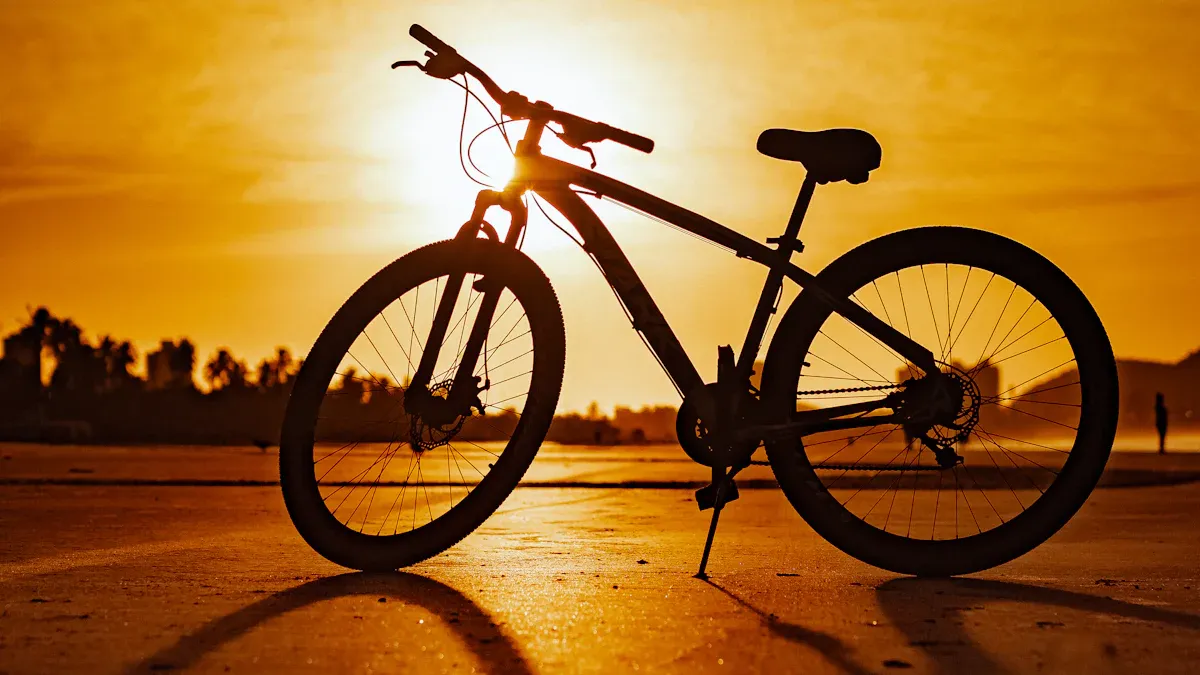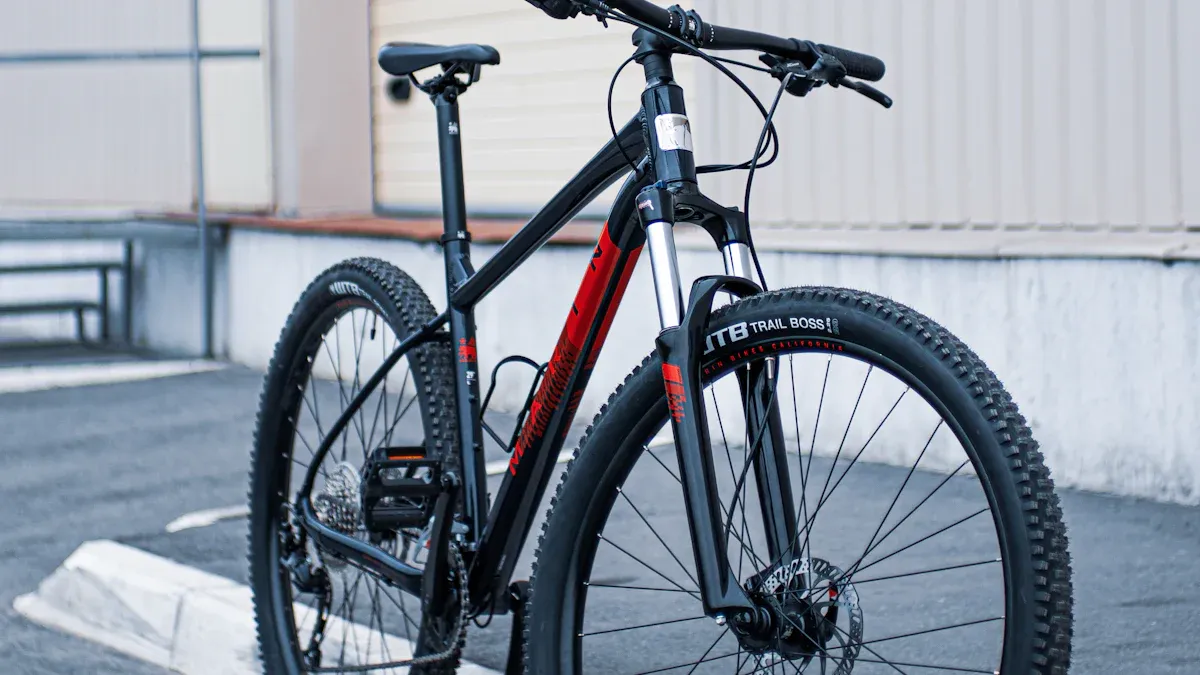
Bike geometry means the exact measurements and angles of a geometry frame bike. Knowing bike geometry is very important for you as a cyclist. It affects your comfort, performance, and safety. For example, a geometry frame bike with a good design can improve your stability and control. Studies show that bike lanes lower crash risks a lot. This shows how geometry matters for safe cycling. By understanding these ideas, you can make smart choices for a better ride.
Key Takeaways
Knowing bike geometry helps you pick the best bike for you. This makes riding more comfortable and better.
Important parts like head tube angle and wheelbase change how your bike rides and feels.
A good bike fit can lessen pain and injuries. This makes your rides more fun.
Different bike types, like road and mountain bikes, have special shapes for different riding styles and places.
Checking your bike’s fit often helps you stay comfortable and perform well while cycling.
What is Bike Geometry?

Bike geometry means the specific measurements and angles of a geometry frame bike. Knowing bike geometry is very important for cyclists. It affects how you ride, how comfortable you are, and how well you can ride.
Geometry Frame Bike
Several key parts make up bike geometry. These include:
Head Tube Angle: This angle changes how your bike feels when you steer. A steeper angle makes it handle faster. A slacker angle gives you more stability.
Fork Rake: This measurement affects how the front wheel touches the ground. It can change your bike’s stability and how quickly it responds.
Wheelbase: The space between the front and back wheels affects how stable your bike feels at high speeds. A longer wheelbase usually gives more stability. A shorter one helps with quick turns.
These parts greatly affect how a bike handles and rides. For example, fast handling needs less effort from the rider but can feel shaky for new riders. On the other hand, slow handling needs more effort to steer, giving more stability and smoother rides.
Impact on Riding Experience
The geometry of your bike is like a recipe. Each part helps create the final riding experience. For example, a trail figure around 58 mm often balances quick and stable handling. When you have good weight distribution and strong frame stiffness, this setup lets you ride hands-off at speed while easily moving around obstacles.
Different frame geometries also change your body angles and weight distribution. An aerodynamic rider position makes you smaller, which helps you ride better. For example, racing road bikes have a more aggressive geometry for better speed. In contrast, endurance road bikes give a more stable and comfy riding position, great for long rides.
Changes in bike geometry can help with handling and stability, especially in an aero position. This is important for reducing tiredness and discomfort during long rides. Studies show that a proper bike fit can greatly lower riding discomfort and pain. After a standard bike fit session, many riders feel more comfortable even months later.
Knowing how bike geometry affects your riding helps you make smart choices. Skilled riders often change their techniques to use their bike’s dynamic geometry. This knowledge improves handling and performance, making the ride better based on each rider’s skill level.
Effect on Riding Experience | |
|---|---|
Head Angle | Affects stability and handling, crucial for different skill levels |
Wheelbase | Influences maneuverability and responsiveness to rider inputs |
Chainstay Length | Impacts stability during dynamic movements, important for various terrains |
Key Geometry Components

Knowing the key geometry parts of your bike is important. It helps you get a good fit and enjoy your ride more. Here are the main parts that make up bike geometry:
Frame Size
Frame size is very important for comfort and performance. It decides how well the bike fits your body. If the frame size is wrong, it can cause discomfort and injuries. For example, if the frame is too big, you may have trouble reaching the handlebars. If it’s too small, you might feel squished.
Here’s a quick guide for frame sizes based on rider height:
Frame Size | Suggested Rider Height |
|---|---|
XS | 4’11”-5’2″ |
S | 5’2″-5’5″ |
M | 5’5″-5’9″ |
L | 5’9″-6’1″ |
XL | 6’1″-6’4″ |
XXL | 6’4″-6’8″ |
Choosing the right frame size helps you sit properly. This can improve your performance and lower the risk of injuries like trochanteric bursitis and biker’s knee.
Stack and Reach
Stack and reach measurements help you see if a bike will give you the right riding position.
Stack: This is the vertical distance from the bottom bracket to the top of the head tube. It affects how high the front end is, changing how upright or aggressive your riding position is.
Reach: This is the horizontal distance from the bottom bracket to the top of the head tube. It decides how stretched out or compact your position is.
These measurements make it easier to compare bike geometries. Adjusting stack and reach can change weight distribution and handling, which are important for performance.
Head Tube Angle
The head tube angle greatly affects how your bike handles.
A steeper head tube angle (around 73.5-75 degrees) gives quicker, more responsive steering. This is great for cross-country riding where being agile is important.
A slacker head tube angle improves stability, especially at high speeds. This helps for downhill riding or when carrying cargo.
The mix of head tube angle and fork rake is key for overall handling. A good setup lets you ride on different terrains with confidence.
Wheelbase
The wheelbase is the distance between the front and back wheels. It is very important for your bike’s stability and how easy it is to steer.
Shorter wheelbases are better for tight trails. They are great for tough terrains and allow for better agility and tighter turns.
Longer wheelbases give stability at high speeds. They are good for highway riding and make for a smoother ride by lessening the bumps from the road.
Understanding how wheelbase length affects steering and ride quality helps you pick a bike that matches your riding style.
Comparing Bike Types
When picking a bike, it’s important to know how road bikes and mountain bikes are different. Each bike type has its own purpose and gives you a unique riding experience.
Road Bike Geometry
Road bikes are made for speed and efficiency. They have a more aggressive geometry, which puts you in a lower and longer position. This design helps you go faster by reducing drag. Here are some main features of road bike geometry:
Frame Weight: Road bikes use light frames to go faster.
Tire Type: They have skinny, smooth tires that reduce rolling resistance.
Riding Position: You sit in an aerodynamic position, which helps you keep speed over long distances.
Gear Ratio: Road bikes focus on maximum speed, making them great for paved roads.
The geometry of road bikes helps you ride faster and more efficiently. But this aggressive position might not feel comfortable for everyone, especially on long rides.
Mountain Bike Geometry
Mountain bikes focus on stability and control on rough ground. Their geometry is made to handle bumps and give you a comfy ride. Here are some key features of mountain bike geometry:
Frame Weight: Mountain bikes have stronger frames for tough conditions.
Tire Type: They come with wide, treaded tires for better grip on uneven surfaces.
Riding Position: You sit more upright, which makes it more comfortable and gives you better control.
Head Tube Angle: A slacker angle helps with stability, especially when going downhill.
The differences in geometry really change how you ride. For example, mountain bike geometry gives you better control and stability on bumpy trails, helping you go down steep hills confidently.
Feature | Road Bikes | Mountain Bikes |
|---|---|---|
Frame Weight | Lightweight frames | Heavy-duty frames |
Tire Type | Skinny, smooth tires | Wide, treaded tires |
Riding Position | Aerodynamic positioning | Upright positioning |
Gear Ratio | Skewed towards maximum speed | Skewed towards steep terrain |
Ideal Terrain | Paved surfaces | Off-road trails |
Knowing these differences helps you pick the right bike for how you like to ride. Whether you want the speed of road bike geometry or the stability of mountain bike geometry, understanding what each one offers will make your cycling experience better.
Knowing bike geometry is very important for choosing the right bike and getting a good fit. Here are some main benefits of looking at geometry:
A good fit can help you ride better more than fancy parts.
Different ways of riding need different geometry ideas.
Benefit | Description |
|---|---|
Improved Comfort | Knowing geometry helps you pick a bike that suits your body. |
Enhanced Performance | Good geometry helps you use your power better when pedaling. |
Increased Satisfaction | A bike that fits you well makes you happier while riding. |
By focusing on geometry, you can make your cycling better and enjoy every ride.
FAQ
What is the best way to measure my bike frame size?
To measure your bike frame size, stand over the top tube. You should have 1-2 inches of clearance for road bikes and 2-4 inches for mountain bikes. Use a tape measure to find your inseam length and consult size charts for the right frame.
How does bike geometry affect comfort?
Bike geometry affects your riding position. A well-fitted bike allows you to maintain a comfortable posture, reducing strain on your back and neck. Proper geometry helps you enjoy longer rides without discomfort.
Can I adjust my bike’s geometry?
You can adjust some aspects of your bike’s geometry. Changing the stem length or handlebar height can alter your riding position. However, significant changes may require a new frame or professional fitting.
Why is stack and reach important?
Stack and reach measurements help you find the right fit for your body. They determine how upright or stretched out you feel while riding. Proper stack and reach improve comfort and performance.
How often should I check my bike’s fit?
You should check your bike’s fit at least once a year or whenever you change your riding style or body shape. Regular adjustments ensure optimal comfort and performance, helping you enjoy your rides more.
See Also
The Importance of Selecting Proper Bike Frame Geometry
Understanding Mountain Bike Sizes Through Geometry Insights
Simplifying Mountain Bike Frame Sizes and Geometry Concepts
The Significance of Bike Frame Angles for Comfort
Transformative MTB Frame Designs That Enhance Your Experience
